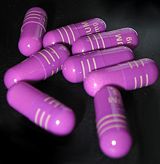Pharmaceutical Drugs
From Proteopedia
| Line 1: | Line 1: | ||
[[Image: Nexium.jpg|160px|right|thumb|AstraZeneca’s Nexium]] | [[Image: Nexium.jpg|160px|right|thumb|AstraZeneca’s Nexium]] | ||
| - | The Pharmaceutical industry is one of the world’s largest industries, grossing well over $300 billion in the United States alone. Understanding how the drugs the pharma industry develops work and different characteristics of these compounds is important to nearly everyone as 50% of the US population takes at least one prescription medication regularly and nearly everyone takes a pharmaceutical pill at some point in their life.<ref>http://www.npr.org/blogs/health/2010/09/03/129626052/a-portrait-of-health-prescription-drugs-in-america</ref> The following is a growing list of pharmaceutical compounds organized by disorder. | + | The Pharmaceutical industry is one of the world’s largest industries, grossing well over $300 billion in the United States alone. Understanding how the drugs the pharma industry develops work and different characteristics of these compounds is important to nearly everyone as 50% of the US population takes at least one prescription medication regularly and nearly everyone takes a pharmaceutical pill at some point in their life.<ref>http://www.npr.org/blogs/health/2010/09/03/129626052/a-portrait-of-health-prescription-drugs-in-america</ref> See also [[WHO Model Lists of Essential Medicines]]. The following is a growing list of pharmaceutical compounds organized by disorder. |
<br /> | <br /> | ||
<br/> | <br/> | ||
Revision as of 13:03, 11 January 2024
The Pharmaceutical industry is one of the world’s largest industries, grossing well over $300 billion in the United States alone. Understanding how the drugs the pharma industry develops work and different characteristics of these compounds is important to nearly everyone as 50% of the US population takes at least one prescription medication regularly and nearly everyone takes a pharmaceutical pill at some point in their life.[1] See also WHO Model Lists of Essential Medicines. The following is a growing list of pharmaceutical compounds organized by disorder.
See Pharmaceutical Drug Targets for a list of drug targets organized by disease.
The majority of all modern medicinal drugs target members of the superfamily of proteins called the G protein-coupled receptors or GPCRs[2][3].
Treatments
The following is a list of pharmaceutical treatments for various diseases, organized by disorder. Each entry highlights general information about the therapeutic, pharmacokinetic data comparisons within its drug class, and a structural analysis explaining how the drug compound functions in vivo.
Alzheimer's Disease |
Bacterial Infection |
Cancer |
|||
|
|
|
|||
Depression |
Diabetes |
Erectile Dysfunction |
|||
|
|
||||
Hypercholeseterolemia |
Hypertension |
HIV |
|||
|
|
|
|||
Inflammation & Arthritis |
Influenza |
Opioid drugs |
|||
|
|
|
References
- ↑ http://www.npr.org/blogs/health/2010/09/03/129626052/a-portrait-of-health-prescription-drugs-in-america
- ↑ Overington JP, Al-Lazikani B, Hopkins AL. How many drug targets are there? Nat Rev Drug Discov. 2006 Dec;5(12):993-6. PMID:17139284 doi:10.1038/nrd2199
- ↑ Peeters MC, van Westen GJ, Li Q, IJzerman AP. Importance of the extracellular loops in G protein-coupled receptors for ligand recognition and receptor activation. Trends Pharmacol Sci. 2011 Jan;32(1):35-42. PMID:21075459 doi:10.1016/j.tips.2010.10.001
Proteopedia Page Contributors and Editors (what is this?)
David Canner, Alexander Berchansky, Michal Harel, Karsten Theis, Wayne Decatur

